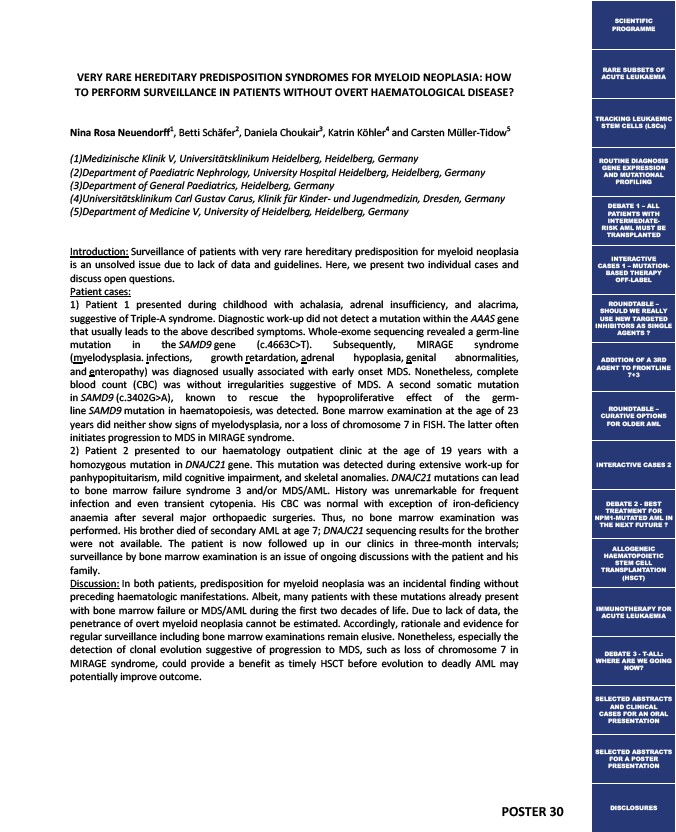
VERY RARE HEREDITARY PREDISPOSITION SYNDROMES FOR MYELOID NEOPLASIA: HOW
TO PERFORM SURVEILLANCE IN PATIENTS WITHOUT OVERT HAEMATOLOGICAL DISEASE?
POSTER 30
Nina Rosa Neuendorff1, Betti Schäfer2, Daniela Choukair3, Katrin Köhler4 and Carsten Müller-Tidow5
(1)Medizinische Klinik V, Universitätsklinikum Heidelberg, Heidelberg, Germany
(2)Department of Paediatric Nephrology, University Hospital Heidelberg, Heidelberg, Germany
(3)Department of General Paediatrics, Heidelberg, Germany
(4)Universitätsklinikum Carl Gustav Carus, Klinik für Kinder- und Jugendmedizin, Dresden, Germany
(5)Department of Medicine V, University of Heidelberg, Heidelberg, Germany
Introduction: Surveillance of patients with very rare hereditary predisposition for myeloid neoplasia
is an unsolved issue due to lack of data and guidelines. Here, we present two individual cases and
discuss open questions.
Patient cases:
1) Patient 1 presented during childhood with achalasia, adrenal insufficiency, and alacrima,
suggestive of Triple-A syndrome. Diagnostic work-up did not detect a mutation within the AAAS gene
that usually leads to the above described symptoms. Whole-exome sequencing revealed a germ-line
mutation in the SAMD9 gene (c.4663C>T). Subsequently, MIRAGE syndrome
(myelodysplasia. infections, growth retardation, adrenal hypoplasia, genital abnormalities,
and enteropathy) was diagnosed usually associated with early onset MDS. Nonetheless, complete
blood count (CBC) was without irregularities suggestive of MDS. A second somatic mutation
in SAMD9 (c.3402G>A), known to rescue the hypoproliferative effect of the germ-line
SAMD9 mutation in haematopoiesis, was detected. Bone marrow examination at the age of 23
years did neither show signs of myelodysplasia, nor a loss of chromosome 7 in FISH. The latter often
initiates progression to MDS in MIRAGE syndrome.
2) Patient 2 presented to our haematology outpatient clinic at the age of 19 years with a
homozygous mutation in DNAJC21 gene. This mutation was detected during extensive work-up for
panhypopituitarism, mild cognitive impairment, and skeletal anomalies. DNAJC21 mutations can lead
to bone marrow failure syndrome 3 and/or MDS/AML. History was unremarkable for frequent
infection and even transient cytopenia. His CBC was normal with exception of iron-deficiency
anaemia after several major orthopaedic surgeries. Thus, no bone marrow examination was
performed. His brother died of secondary AML at age 7; DNAJC21 sequencing results for the brother
were not available. The patient is now followed up in our clinics in three-month intervals;
surveillance by bone marrow examination is an issue of ongoing discussions with the patient and his
family.
Discussion: In both patients, predisposition for myeloid neoplasia was an incidental finding without
preceding haematologic manifestations. Albeit, many patients with these mutations already present
with bone marrow failure or MDS/AML during the first two decades of life. Due to lack of data, the
penetrance of overt myeloid neoplasia cannot be estimated. Accordingly, rationale and evidence for
regular surveillance including bone marrow examinations remain elusive. Nonetheless, especially the
detection of clonal evolution suggestive of progression to MDS, such as loss of chromosome 7 in
MIRAGE syndrome, could provide a benefit as timely HSCT before evolution to deadly AML may
potentially improve outcome.
SCIENTIFIC
PROGRAMME
RARE SUBSETS OF
ACUTE LEUKAEMIA
TRACKING LEUKAEMIC
STEM CELLS (LSCs)
ROUTINE DIAGNOSIS
GENE EXPRESSION
AND MUTATIONAL
PROFILING
DEBATE 1 – ALL
PATIENTS WITH
INTERMEDIATE-RISK
AML MUST BE
TRANSPLANTED
INTERACTIVE
CASES 1 – MUTATION-BASED
THERAPY
OFF-LABEL
ROUNDTABLE –
SHOULD WE REALLY
USE NEW TARGETED
INHIBITORS AS SINGLE
AGENTS ?
ADDITION OF A 3RD
AGENT TO FRONTLINE
7+3
ROUNDTABLE –
CURATIVE OPTIONS
FOR OLDER AML
INTERACTIVE CASES 2
DEBATE 2 - BEST
TREATMENT FOR
NPM1-MUTATED AML IN
THE NEXT FUTURE ?
ALLOGENEIC
HAEMATOPOIETIC
STEM CELL
TRANSPLANTATION
(HSCT)
IMMUNOTHERAPY FOR
ACUTE LEUKAEMIA
DEBATE 3 - T-ALL:
WHERE ARE WE GOING
NOW?
SELECTED ABSTRACTS
AND CLINICAL
CASES FOR AN ORAL
PRESENTATION
SELECTED ABSTRACTS
FOR A POSTER
PRESENTATION
DISCLOSURES